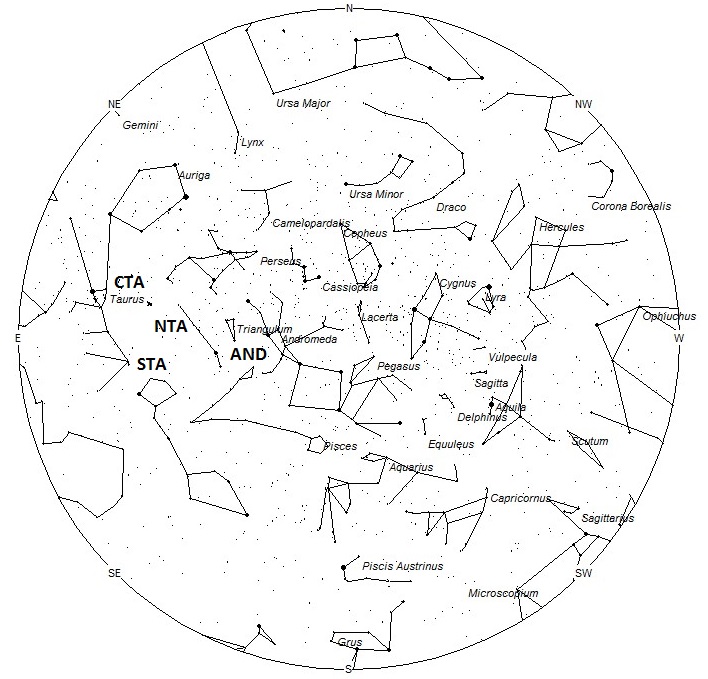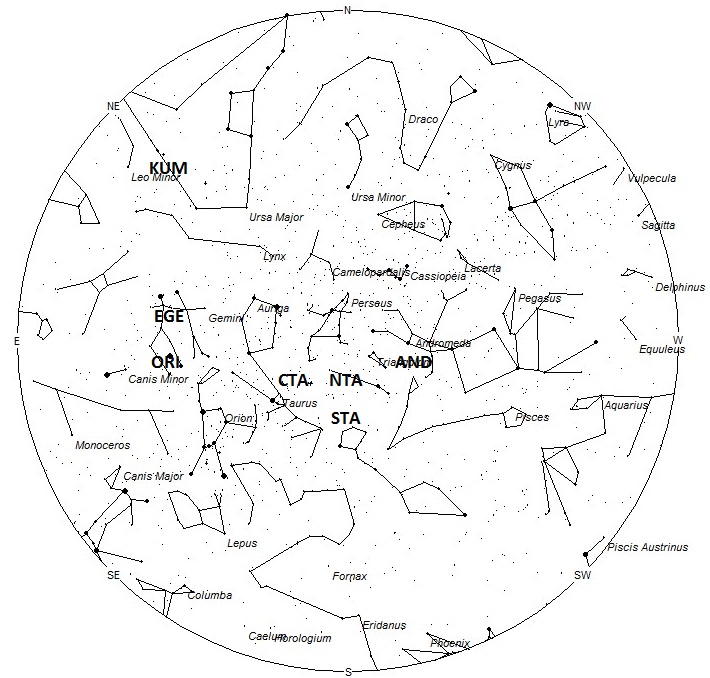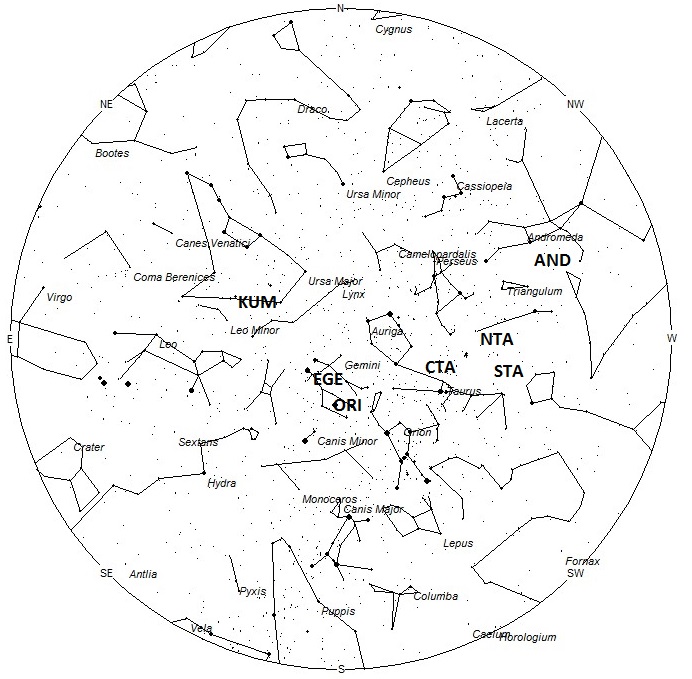
Photo of AMS Event#2824-2015 Oct 31st 2015, Czernice Borowe, Poland © Grzegorz Zieleniecki
During this period the moon reaches its new phase on Tuesday November 11th. On that date the moon will be located near the sun and will not be visible at night. This weekend the waning crescent moon will rise during the late morning hours but will be too thin to cause problems for meteor observers. The estimated total hourly meteor rates for evening observers this week is near 4 as seen from mid-northern latitudes (45N) and 3 as seen from tropical southern locations (25S). For morning observers the estimated total hourly rates should be near 13 as seen from mid-northern latitudes (45N) and 11 as seen from tropical southern locations (25S). The actual rates will also depend on factors such as personal light and motion perception, local weather conditions, alertness and experience in watching meteor activity. Rates during the morning hours are reduced during this period due to moonlight. Note that the hourly rates listed below are estimates as viewed from dark sky sites away from urban light sources. Observers viewing from urban areas will see less activity as only the brightest meteors will be visible from such locations.
The radiant (the area of the sky where meteors appear to shoot from) positions and rates listed below are exact for Saturday night/Sunday morning November 7/8. These positions do not change greatly day to day so the listed coordinates may be used during this entire period. Most star atlases (available at science stores and planetariums) will provide maps with grid lines of the celestial coordinates so that you may find out exactly where these positions are located in the sky. A planisphere or computer planetarium program is also useful in showing the sky at any time of night on any date of the year. Activity from each radiant is best seen when it is positioned highest in the sky, either due north or south along the meridian, depending on your latitude. It must be remembered that meteor activity is rarely seen at the radiant position. Rather they shoot outwards from the radiant so it is best to center your field of view so that the radiant lies at the edge and not the center. Viewing there will allow you to easily trace the path of each meteor back to the radiant (if it is a shower member) or in another direction if it is a sporadic. Meteor activity is not seen from radiants that are located below the horizon. The positions below are listed in a west to east manner in order of right ascension (celestial longitude). The positions listed first are located further west therefore are accessible earlier in the night while those listed further down the list rise later in the night.
These sources of meteoric activity are expected to be active this week.
The Andromedids (AND) are active from a radiant located at 01:32 (023) +29, which lies in northern Pisces, 5 degrees west of the 3rd magnitude star known as Alpha Trianguli. This is a famous shower that produced some brilliant displays during the 19th century. Since then the main orbit of the particles from comet 3D/Biela have moved away from the Earth. Still, remnants may be seen from October 26 through November 20 with maximum activity occurring on November 8. These meteors are best seen near 2300 (10pm) local standard time (LST) when the radiant lies highest above the horizon. Rates should be near 1 per hour as seen from the northern hemisphere and less than 1 as seen south of the equator. With an entry velocity of 16 km/sec., the average Andromedid meteor would be of slow velocity.
The Northern Taurids (NTA) are active from a large radiant centered at 03:36 (054) +22. This position lies in western Taurus, 3 degrees southwest of the naked eye open cluster known as the Pleiades or M45. The radiant is best placed near midnight local standard time (LST), when it lies highest above the horizon. Meteors from the Northern Taurids strike the atmosphere at 27km/sec., which would produce meteors of slow velocity. Expected rates would be near 3 per hour, no matter your location.
The Southern Taurids (STA) are currently active from a large radiant centered at 03:36 (054) +15. This position also lies in western Taurus, 10 degrees southwest of the the Pleiades. These meteors may be seen all night long but the radiant is best placed near midnight LST when it lies on the meridian and is located highest in the sky. Rates at this time should be near 2 per hour regardless of your location. With an entry velocity of 29 km/sec., the average Southern Taurid meteor would be of slow velocity. Note that this position is close to the Northern Taurid radiant. Care must be taken to differentiate between these meteors. The NTA’s are of similar velocity.
The Orionids (ORI) are active from a radiant at 07:08 (107) +17, which places it in southern Gemini, 2 degrees west of the faint star known as Lambda Geminorum. This area of the sky is best placed in the sky near 0400 LST, when it lies highest above the horizon. The expected rates should be near 2 per hour no matter your location. With an entry velocity of 67 km/sec., most activity from this radiant would be of swift speed.
Activity from the Leonids (LEO) should now be visible in the morning sky. This well-known shower is active from November 5-December 3 with maximum activity occurring near November 19th. The radiant is currently located at 09:40 (145) +25. This area of the sky is located in northwestern Leo, 2 degrees northeast of the 3rd magnitude star known as Ras Elased (Epsilon Leonis). Rates are expected to be near 1 per hour regardless of your location. These meteors are best seen during the last hour before dawn when the radiant lies highest above the horizon in a dark sky. With an entry velocity of 70 km/sec., the average Leonid meteor would be of swift velocity.
The Kappa Ursae Majorids (KUM) were discovered by cameras of the SonotaCo network in Japan during an outburst of activity on November 5, 2009. This radiant is active from November 2-9 with maximum activity occurring on the 5th. The last of these meteors are expected this weekend from a radiant located at 09:48 (147) +44. This position lies in southeastern Ursa Majoris, 5 degrees northwest of the 3rd magnitude star known as Tania Borealis (Lambda Ursae Majoris). Rates are expected to be less than 1 regardless of your location. These meteors are best seen during the last hour before dawn when the radiant lies highest above the horizon in a dark sky. With an entry velocity of 62 km/sec., the average Kappa Ursae Majorid meteor would be of swift velocity.
The November Iota Draconids (NID) were discovered by Dr. Peter Brown during his 7 year meteoroid stream survey using the Canadian Meteor Orbit Radar. This source is active from November 11 through the 1st of December with maximum activity occurring on November 21st. The radiant is currently located at 12:00 (180) +74. This area of the sky lies in western Draco, 20 degrees north of the 2nd magnitude star known as Phecda (Gamma Ursae Majoris). The radiant is best placed during the last hour before morning twilight when the radiant lies highest in a dark sky. Since maximum activity is still more than a week away current rates would be less than one shower member per hour, no matter your location. Due to the high northerly declination of the radiant these meteors are not visible from most of the southern hemisphere. Only southern equatorial regions would have any chance of seeing activity from this source. Meteors from the November Iota Draconids strike the atmosphere at 41km/sec., which would produce meteors of medium velocity.
As seen from the mid-northern hemisphere (45N) one would expect to see approximately 11 sporadic meteors per hour during the last hour before dawn as seen from rural observing sites. Evening rates would be near 4 per hour. As seen from the tropical southern latitudes (25S) morning rates would be near 8 per hour as seen from rural observing sites and 3 per hour during the evening hours. Locations between these two extremes would see activity between the listed figures.
The list below offers the information from above in tabular form. Rates and positions are exact for Saturday night/Sunday morning except where noted in the shower descriptions.
| SHOWER | DATE OF MAXIMUM ACTIVITY | CELESTIAL POSITION | ENTRY VELOCITY | CULMINATION | HOURLY RATE | CLASS |
| RA (RA in Deg.) DEC | Km/Sec | Local Standard Time | North-South | |||
| Andromedids (AND) | Nov 08 | 01:32 (023) +29 | 19 | 22:00 | 1 – <1 | III |
| Northern Taurids (NTA) | Nov 11 | 03:36 (054) +22 | 27 | 00:00 | 3 – 3 | II |
| Southern Taurids (STA) | Oct 10 | 03:36 (054) +15 | 29 | 00:00 | 2 – 2 | II |
| Orionids (ORI) | Oct 22 | 07:08 (107) +17 | 67 | 04:00 | 2 – 2 | I |
| Leonids (LEO) | Nov 19 | 09:40 (145) +25 | 70 | 07:00 | 1 – 1 | III |
| Kappa Ursa Majorids (KUM) | Nov 05 | 09:48 (147) +44 | 62 | 07:00 | <1 – <1 | IV |
| November Iota Draconids (NID) | Nov 21 | 12:00 (180) +74 | 41 | 05:00 | <1 – <1 | II |
 American Meteor Society
American Meteor Society



Do you have any kind of analysis on the overall increase or decrease of fireball activity world wide?
Drew and All,
We can only analyze our own results which indicate a sharp rise in fireball reports between 2005 and 2012. I believe this increase is strictly due to the growing popularity of the fireball form. For the last 3 years the reports have leveled off even though we are getting more exposure across the globe through the help of the International Meteor Organization and the availability of the fireball on their web site.
Robert Lunsford
Saw metero 8:31 pm from moon township, Pa 15108 coming from the Hercules Constellation. Coming north shooting 1200 o’clock shooting to east to 400 O’Clock
Saw the sky flash blue and then to purple at about 9pm central time near Burr Ridge IL. This happened twice. I assume it was a meteor or two?